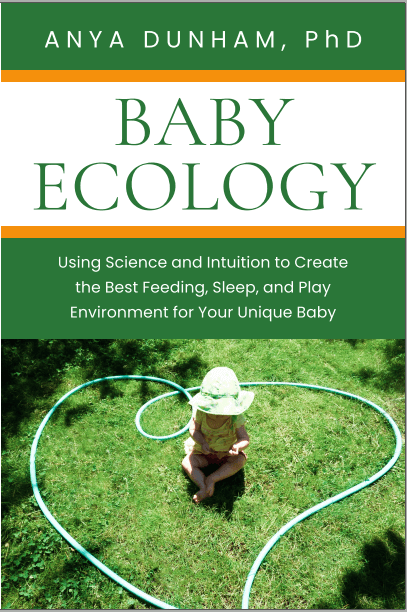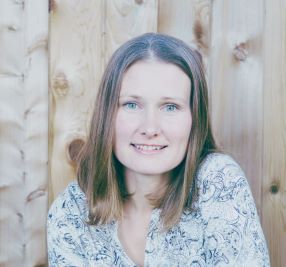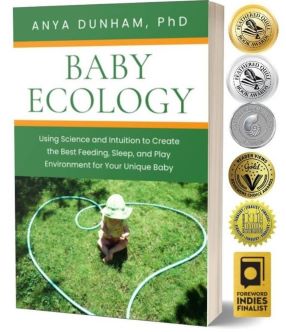Baby Ecology book is here! Learn more
Baby Ecology book is here!
- Home
- Help baby sleep
3 key things to help baby sleep better
by Anya Dunham, PhD
Universal , biology-based things to help baby sleep soundly at night and nap predictably during the day - as soon as he or she is ready.
*This article is adapted from one of the chapters in my book, Baby Ecology*
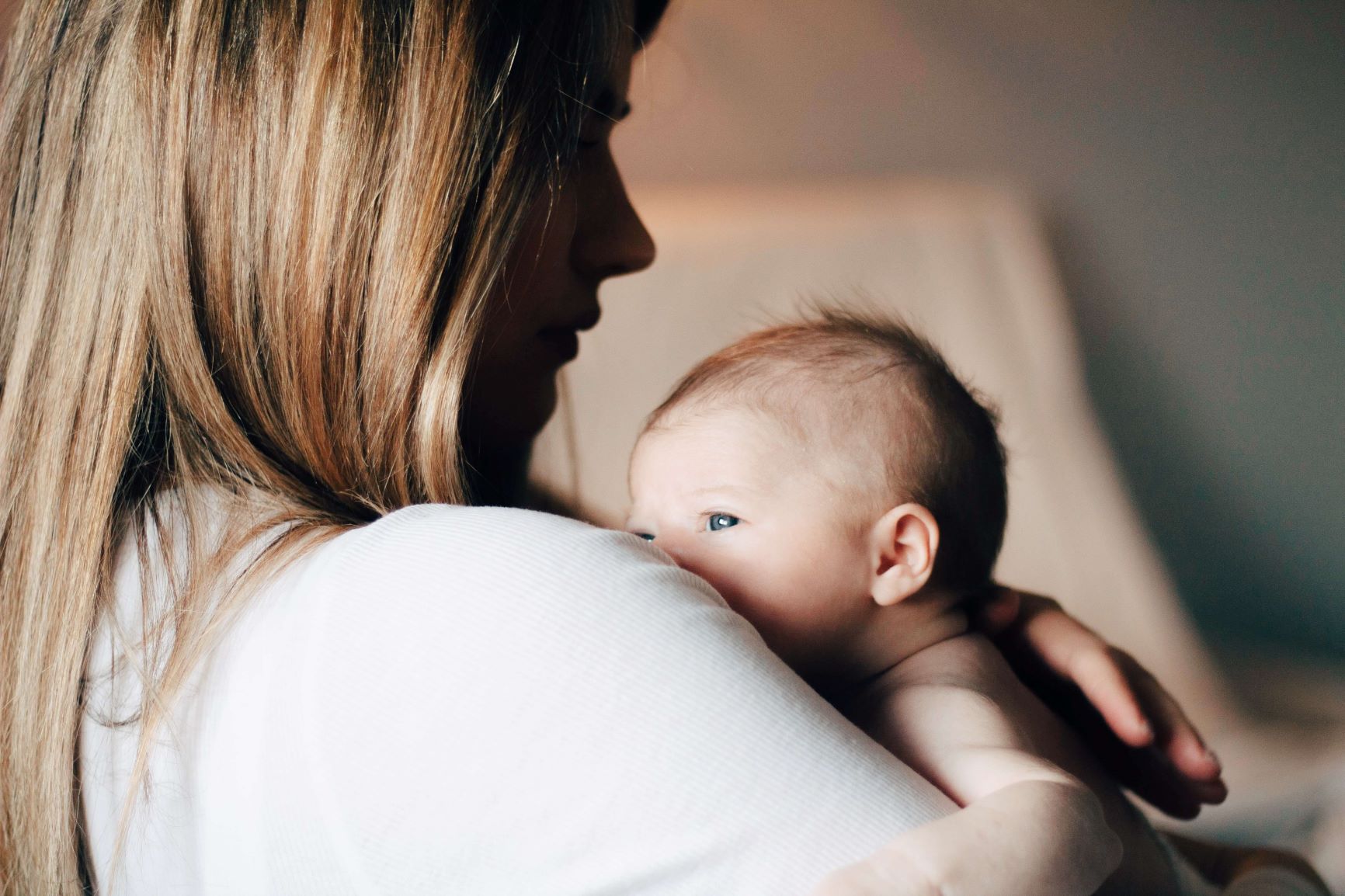
When I was a new mom, I wondered through many sleepless nights and no-good-nap days: What should I do? What am I doing wrong? I had an immense sense of responsibility for my daughter and yet couldn’t figure out what to do to help her sleep better. My baby and I were too exhausted to go on as we were, but sleep training did not sit right with me.
Now, after navigating babyhood with three children and learning about the science behind sleep, I believe that we don’t need to “train” our babies how to sleep. And we don’t have to wait the first months or years out either (and waiting it out does not really work anyway). I believe that our role is to provide 3 key 'things'.
(If your baby isn't here yet or is still a newborn, you might want to also download my free Newborn Sleep Guide.)
Key things to help baby sleep
- Create a safe and soothing sleeping space
- Be warm, responsive, and consistent
- Support a balanced daily rhythm
Let's take a closer look, shall we?
1. A safe and soothing sleeping space
The most important thing about your baby’s sleeping space is, of course, safety. Consult up-to-date sleep recommendations of the American Academy of Pediatrics or an equivalent organization in your country. If you plan on bed-sharing, find a health care practitioner or a professional organization that offers evidence-based advice on how to practice bed-sharing safely in your particular situation. Take time to think through and prepare the sleep space in advance.
After you carefully considered sleep safety, think about the look and feel of the space.
- Keep it cool. Although no specific baby sleep temperature guidelines exist, the rule of thumb is, if the room is comfortable for you, it is comfortable for your baby.1,2 A room thermometer can help you choose baby’s sleepwear. If in doubt, go for under-dressing your baby: if she gets cold, she will wake up and let you know. An over-bundled baby, however, can be too sleepy to call out and may get overheated which poses serious health risks.
- Keep it quiet (or, at least, not too loud). If you are using a white noise or a sound machine, place it as far away from the baby as possible (never on the crib rail) and play the sound at low volume. This contradicts what some sleep programs recommend, I know. But research shows that many sound machines are much too loud for babies3.
- Keep it dark at night. Add blinds or blackout curtains and turn off all lights and screens. Use a dim night light for nighttime feedings and diaper changes, ideally a red or yellow one (not blue LED). White and blue-based lights, such as illuminated screens of TVs, iPads, smart phones, and laptops, may inhibit melatonin production and disrupt the circadian rhythm by tricking baby’s brain into thinking it’s daytime4.
2. Consistent and responsive care
We are shaping our babies’ sleep no matter what we do. Whether you actively soothe your baby to sleep or your baby goes to sleep on his own, he learns to recognize it as a pattern. Swaddling, rocking, nursing, pacifier, bottle, swing, car seat, daddy’s arms… through these experiences our babies learn how to go to sleep and return to sleep.
Babies have short sleep cycles and wake naturally between them. Us adults do too; if all seems well, we turn over, peacefully return to sleep, and don’t recall this brief waking when we get up for the day. Once your baby learn to do that, she will begin “sleeping through the night”. Here is how you can help:
- Be consistent. Sleep associations, or sleep cues, are people, things, and events that a baby associates with going to sleep and getting back to sleep. Babies who consistently experience the same sleep associations when they go to sleep at bedtime and when they wake in the middle of the night are more likely to re-settle on their own.5
Matching going-to-bed associations with middle-of-the-night ones can take many different forms. For example, a baby who bed-shares and falls asleep next to a parent will expect to find a parent next to her in the middle of the night. If she always goes to sleep nursing, she will want to nurse when she wakes. A baby who falls asleep with a pacifier is likely to look for it in the middle of the night. For a baby sleeping in her own room, re-settling independently at night is easier if she consistently falls asleep on her own at bedtime.
- Be warm and responsive. When parents are emotionally available at bedtime – when they are warm, loving, and responsive to baby’s cues – babies sleep better.6 This probably does not surprise you. One way to help your baby feel relaxed, comfortable, and safe is to create a soothing bedtime routine that you and your baby enjoy. Begin this bedtime routine well before your baby is acting tired, so you don’t feel rushed to get her to sleep.
3. A balanced daily rhythm
Day and night sleep are connected. Adjusting baby’s daily rhythm – giving him consistent, predictable opportunities for naps – improves both day and night sleep.7 A well-rested baby’s internal rhythms (homeostatic, circadian, and ultradian drives) are in sync, so it is easier for him to stay alert when awake and relaxed when asleep.
Is your baby waking a lot at night or catnapping (napping for 40 minutes or less)? Try shorter awake windows between naps. On average, the longest awake time is approximately 2 hours for babies under 3 months, 2.5 hours by 4.5 months, and 3.5 hours by 6 months. But, these are the longest awake windows, usually between the last nap of the day and bedtime.8
Your baby will likely need a nap much sooner than those longest awake times. A number of sleep resources recommend 2-hour awake windows, and parents often begin soothing their babies for nap after 2 hours. However, a 3-month-old may need a nap after only 45 minutes; a 6-month-old may be ready for the first nap 90 or so minutes after waking in the morning.
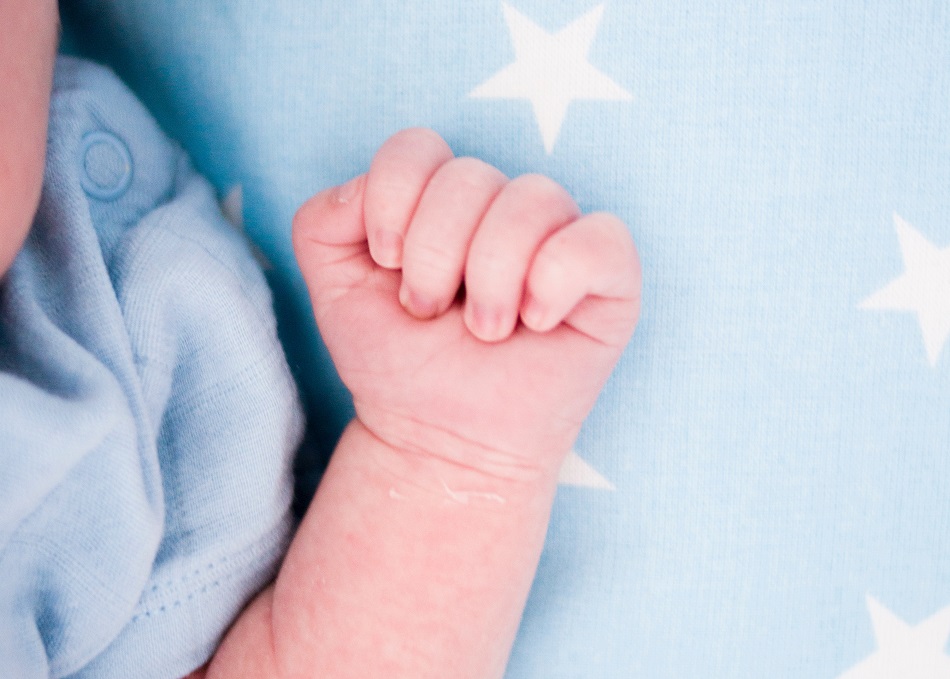
These key things to help baby sleep better - a safe and soothing sleep space, consistent and responsive care, and a balanced daily rhythm - are universal; all babies need them for sound sleep. Do you already have all of these elements in place? Is there anything you can add or adjust to help your baby sleep better?
If your sleep arrangement does not work — or no longer works — for your baby or for yourself, you may want to look into baby sleep programs. But which one to choose? I put together a short quiz to help you pick a baby sleep approach that aligns with your values and your circumstances.
You might also be interested in:
References
References
1. American Academy of Pediatrics (2016) SIDS and other sleep-related infant deaths: Updated 2016 recommendations for a safe infant sleeping environment. Pediatrics. 138(5):e20162938.
2. Public Health Agency of Canada (2014) Safe sleep for your baby. Ottawa, ON, Canada: Health Canada.
3. Hugh SC, Wolter NE, Propst EJ, Gordon KA, Cushing SL, Papsin BC. (2014) Infant sleep machines and hazardous sound pressure levels. Pediatrics 133(4):677-81.
4. Dawson D, Encel N. (1993) Melatonin and sleep in humans. Journal of Pineal Research 15(1):1-12.
5. Latz S, Wolf AW, Lozoff B. (1999) Cosleeping in context: sleep practices and problems in young children in Japan and the United States. Archives of pediatrics & adolescent medicine. 153(4):339-46.
6. Teti DM, Kim B-R, Mayer G, Countermine M. (2010) Maternal emotional availability at bedtime predicts infant sleep quality. Journal of Family Psychology 24(3):307-15.
7. Skuladottir A, Thome M, Ramel A. (2005) Improving day and night sleep problems in infants by changing day time sleep rhythm: a single group before and after study. International Journal of nursing studies 42(8):843-50.
8. Coons S, Guilleminault C. (1982) Development of sleep-wake patterns and non-rapid eye movement sleep stages during the first six months of life in normal infants. Pediatrics 69(6):793-8.
Using hundreds of scientific studies, Baby Ecology connects the dots to help you create the best environment for sleep, feeding, care, and play for your baby.
Warmly,
Anya
